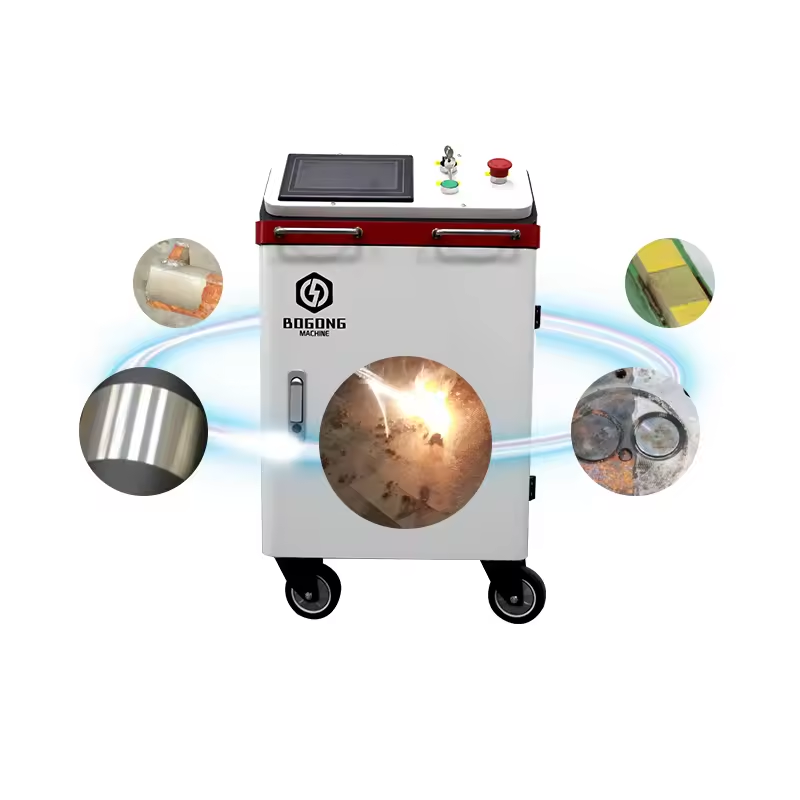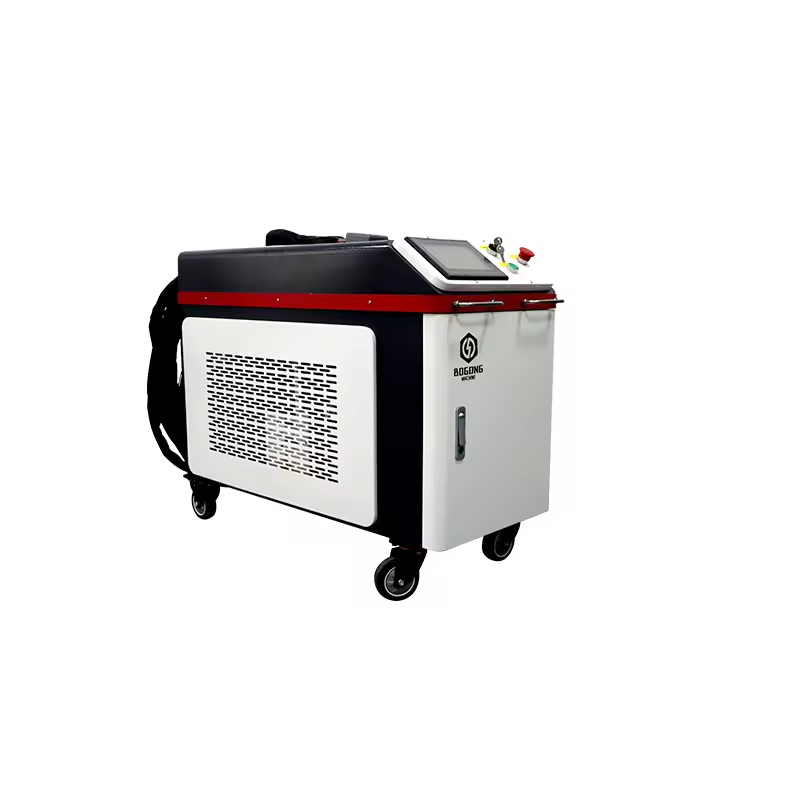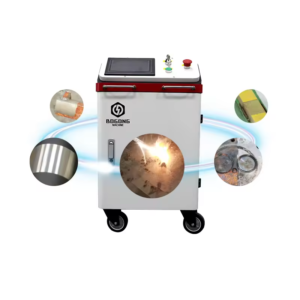휴대용 500W 펄스 레이저 녹 제거기: 효율적인 청소와 손쉬운 녹 제거를 위한 최고의 선택
$22,000.00 - $22,500.00
Laser average power:> 500W
Unstable power supply:>5%
Laser working mode:pulse
Pulse Width:30-500 nanoseconds
Maximum single pulse energy:12.5mJ-50mJ
Power adjustment range (%):10-100
Frequency adjustable range(kHz):10-400
Fiber length:10 meters
Cooling method:Water Cooling
Scanning range (length * width):0-145 mm, continuously adjustable; Dual-axis supports 9 scanning modes;:Scan frequency
Maximum not less than 300Hz
Field lens focal length (mm):254mm (optional 160mm/210mm/330mm/420mm)
Machine dimensions (length, width and height):About 990mm*458mm*791mm
Packaged dimensions (length, width and height):About 1100mm*550mm*900mm
gross weight:Approx. 135 kg
Packing weight:Approximately 165 kg
Features Of 500W Pulse Laser Cleaning Machine
- Safe, non-contact, no damage to the substrate;
- Environmentally friendly, no secondary pollution, and recyclable removed materials;
- Precision control, optional area cleaning, micron level;
- Precision control in the thickness direction;
- Super cost-effective, laser cleaning equipment has no consumables during use, only power consumption.
Machine multi-angle display

The 500W Pulse Laser Cleaning Machine is a state-of-the-art, portable solution designed for efficient and effective surface cleaning across various applications. Utilizing advanced fiber laser technology, this machine can remove rust, contaminants, paint, and other unwanted materials from a range of surfaces without damaging the underlying material.
Video Showcase
500W Pulse Laser Cleaning Machine Main Features
1.High Power Output: With a powerful 500W output, this laser cleaning machine delivers superior cleaning performance, making quick work of even the toughest residues.
2.Portability: Designed for ease of use, the compact and lightweight structure allows for convenient transport and operation in various locations, whether in a workshop or on-site.
3.Environmentally Friendly: Unlike traditional cleaning methods that often require chemicals and solvents, our laser cleaning technology uses minimal to no chemicals, producing less waste and reducing environmental impact.
4.Versatile Applications: Ideal for a wide range of industries, including metalworking, automotive, aerospace, and construction, this machine can effectively clean steel, aluminum, and even delicate surfaces.
5.User-Friendly Interface: Equipped with intuitive controls, the pulse laser cleaning machine is easy to operate, making it accessible for both experienced operators and newcomers.
6.Low Maintenance: The fiber laser technology ensures durability and requires minimal maintenance compared to other cleaning systems, resulting in lower long-term operational costs.
Main accessories

500W Laser Cleaning Machine Pulse Main Application
1.Rust Removal: Efficiently removes rust from metal surfaces, restoring their original condition without abrasive effects.
2.Paint Stripping: Effective for removing old paint, coatings, or adhesive residues from various surfaces, including vehicles, machinery, and equipment.
3.Surface Preparation: Prepares surfaces for painting, welding, or coating by cleaning contaminants, ensuring better adhesion and improved finishing.
4.Cleaning of Industrial Equipment: Removes contaminants from machinery and equipment, extending their lifespan and improving operational efficiency.
5.Restoration of Historical Artifacts: Safely cleans delicate historical artifacts and structures without damaging the underlying materials, making it ideal for restoration projects.
6.Cleaning of Pipes and Tanks: Removes scale, oxidation, and coatings from inside pipes and tanks, ensuring proper functionality and cleanliness.
7.Aerospace and Automotive Applications: Used in the aerospace and automotive industries for cleaning parts and components, ensuring high standards of cleanliness and safety.
8.Debris Removal: Effective in cleaning debris and residues from manufacturing processes, maintaining a clean and safe workspace.
9.Food Industry Equipment Cleaning: Safely cleans machinery and equipment to adhere to hygiene standards without the use of harsh chemicals.
10.Precision Cleaning: Ideal for applications requiring detailed cleaning of intricate parts or components, where traditional methods may be too abrasive or ineffective.
Sample display

Frequently asked questions
What materials can be cleaned with pulse lasers?
1.Metals: Such as steel, aluminum, copper, and alloys, commonly used in industrial applications.
2.Plastics: Certain plastics can be cleaned without damage, depending on their composition and laser settings.
3.Ceramics: Suitable for cleaning ceramics, especially in restoration projects.
4.Glass: Can be used to remove contaminants and coatings.
5.Concrete: Effective for surface preparation and cleaning.
6.Composites: Useful in aerospace and automotive applications, where composite materials are prevalent.
Is pulse laser cleaning environmentally friendly?
Yes, pulse laser cleaning is considered environmentally friendly for several reasons:
Reduced Chemical Use: It typically eliminates the need for harsh chemicals or solvents, which are common in traditional cleaning methods.
Less Waste: The process generates minimal waste, as it primarily vaporizes contaminants rather than displacing them.
Lower Energy Consumption: While not always the case, laser systems can be energy-efficient compared to other cleaning methods.
How does the cost of pulse laser cleaning compare to traditional methods?
The cost comparison can vary based on several factors:
Initial Investment: Pulse laser cleaning machines can have a higher upfront cost than traditional cleaning equipment.
Operational Costs: However, pulse lasers may have lower operational costs over time due to reduced chemical usage, lower labor costs, and minimal maintenance requirements.
Efficiency: The speed and effectiveness of laser cleaning can result in lower total costs in terms of time and labor, especially for large or complex projects.
Overall, while the initial investment is higher, the long-term savings can make laser cleaning more cost-effective.
Can pulse laser cleaning damage delicate surfaces?
Pulse laser cleaning is generally safe for many types of surfaces, but there are some considerations:
Settings Adjustment: The power and pulse frequency can be adjusted to suit the material being cleaned, which helps prevent damage.
Material Sensitivity: Delicate surfaces, such as thin metals or certain composites, may require careful settings or specialized nozzles to avoid damage.
It is essential to conduct tests on a small area before performing full cleaning on sensitive materials to ensure no adverse effects occur.
What maintenance is required for pulse laser cleaning equipment?
Regular Inspection: Routine checks of the laser source, optics, and cooling system to ensure optimal performance.
Cleaning Optics: Keeping the laser lens and other optical components clean to maintain efficiency and output quality.
Software Updates: Regularly updating the system’s software to benefit from feature improvements and improved safety protocols.
Calibration: Periodic calibration of the laser settings to ensure accuracy.
Scheduled Maintenance: Following the manufacturer’s recommended maintenance schedule for parts replacement and system checks.
Overall, maintenance is typically less intensive than that required for traditional cleaning systems, contributing to the overall efficiency of the laser cleaning process.
“Portable 500W Pulse Laser Rust Remover: The Best Choice For Efficient Cleaning And Easy Rust Removal”의 첫 상품평을 남겨주세요 응답 취소
연관 상품
펄스 레이저 청소기
펄스 레이저 청소기
펄스 레이저 청소기
펄스 레이저 청소기
펄스 레이저 청소기
광섬유 레이저 청소기





















상품평
아직 상품평이 없습니다.